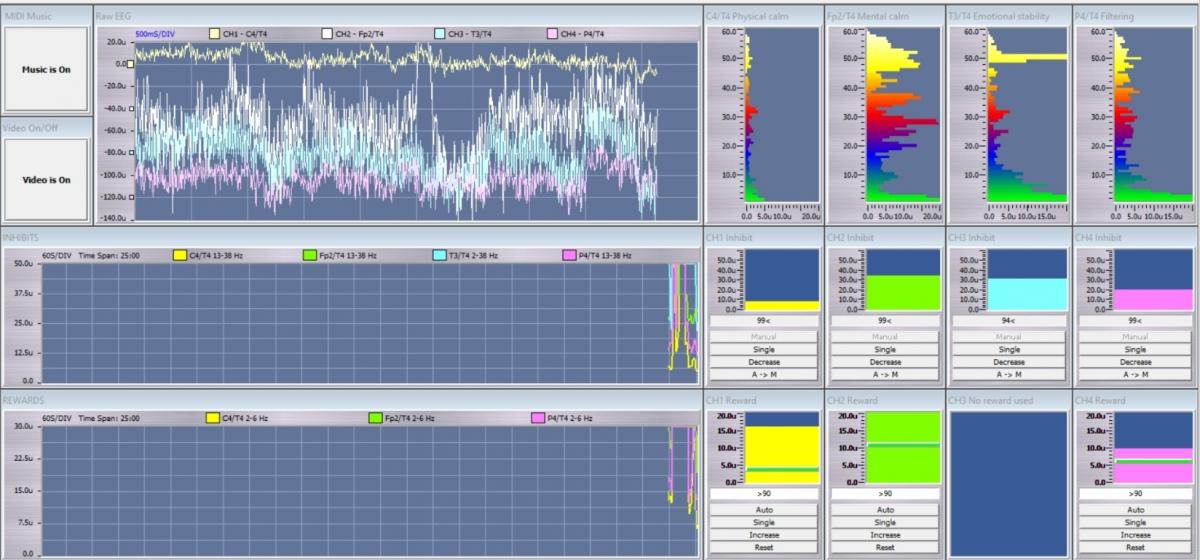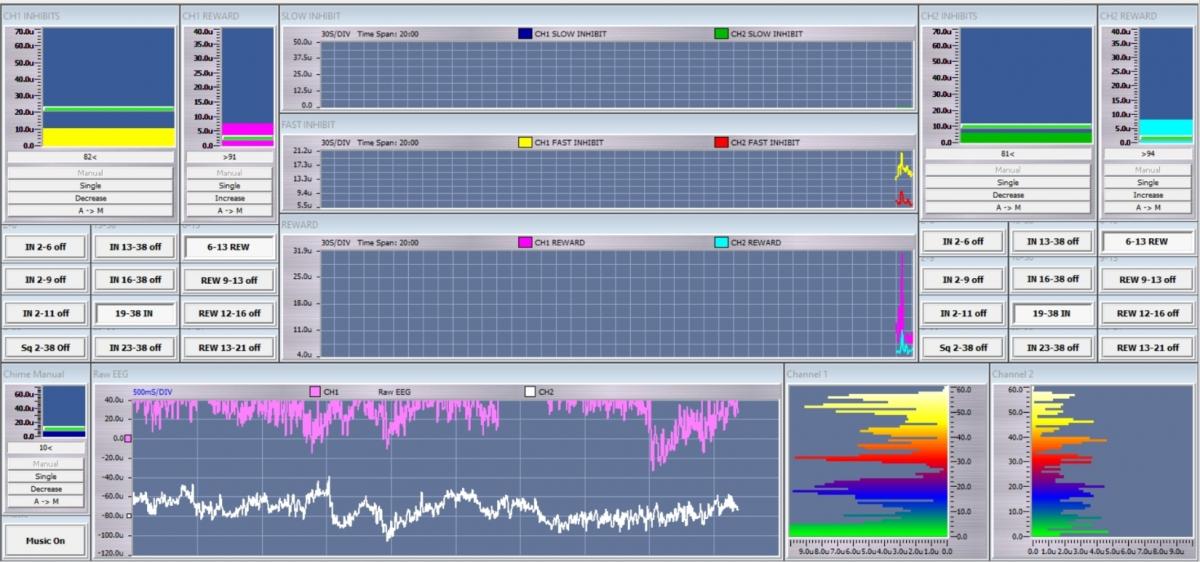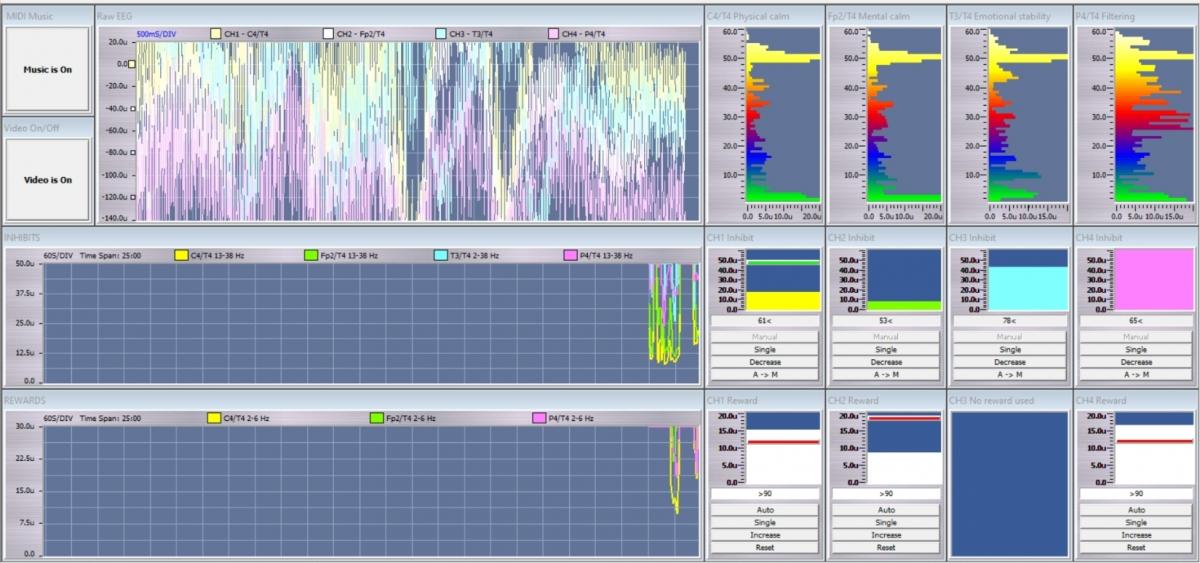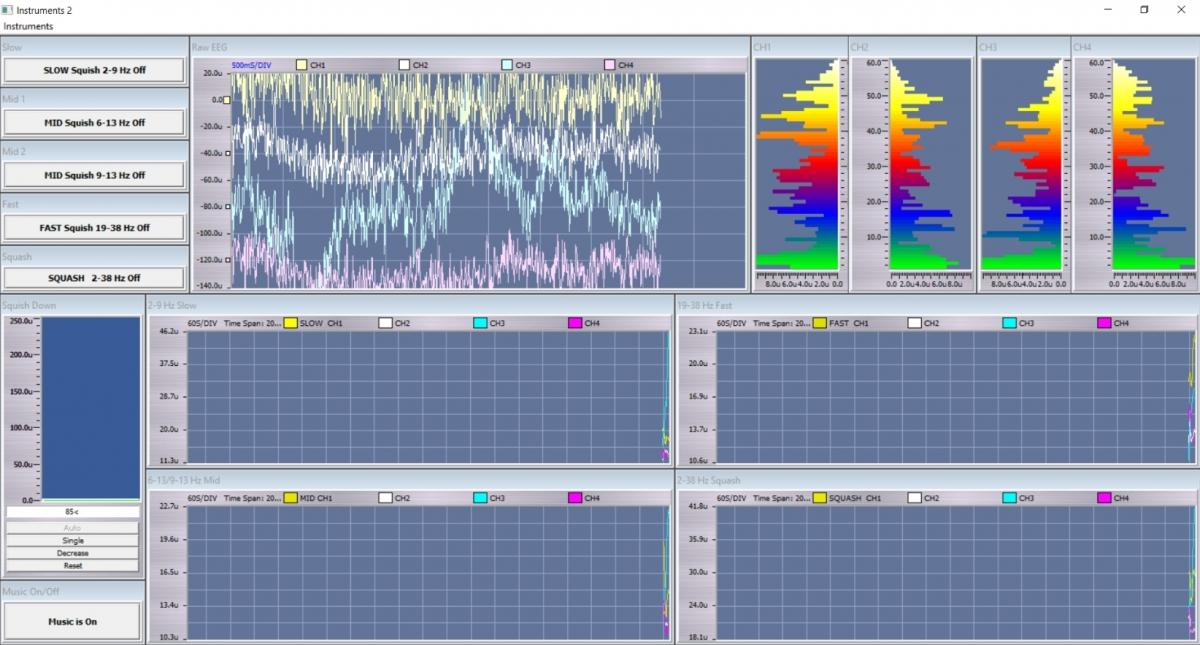Signal Quality – Recognize and achieve a good EEG signal
A clean signal free of artifact is essential to getting good data for a Brain-Trainer assessment. The four sections below cover 1) recognizing a good signal, 2) discussion of signal issues, 3) minimizing artifact and 4) electrical mains interference. Watch the video and read the discussion below. Remember to refer to this page when you have difficulty getting a clean signal.
Signal Quality
When observing signal quality, look for any kind of standing spike–a tall frequency bar in the power spectrum at one or more frequencies, that doesn’t fluctuate like the rest of the bars. when you see these, in one channel, it’s often a bad electrode.
Watch for any kind of surging activity. You may note that all the low frequencies, say from 2-7 hz, all surge out (become longer bars) at the same time and then return at the same time. These are usually artifacts, often eye moves or blinks, or movements of the cable. All frequencies surging out and back together is often an indication of a muscle artifact.
When you have two channels from homologous sites, like C3 and C4 or P3 and P4 showing much longer bars in most or all frequencies on one side than on the other, it’s often a poor connection on the lower side.
Signal quality discussion with images below
Harmonics
This is one of the most common artifacts we see. Check electrode quality.
Image 1 Channel 1 (the first power spectrum on the left) looks like a clean signal. Channel 2 shows a lot of very fast (red and yellow) activity above 30 Hz, but there is no spike. This could be a fast EEG, or the client could be tense in that area, but the connection is probably okay. Channel 3 shows a reasonably good EEG, but we can see the spike at 50 Hz, so I would take a shot at re-applying that electrode to see if I could fix the problem. Channel 4 also looks like a decent signal without a spike. On the oscilloscope we can only see that 1 and 4 look okay but 2 and 3 not so good. It’s not easy to tell what the problem is.
Channel 1 (the first power spectrum on the left) looks like a clean signal. Channel 2 shows a lot of very fast (red and yellow) activity above 30 Hz, but there is no spike. This could be a fast EEG, or the client could be tense in that area, but the connection is probably okay. Channel 3 shows a reasonably good EEG, but we can see the spike at 50 Hz, so I would take a shot at re-applying that electrode to see if I could fix the problem. Channel 4 also looks like a decent signal without a spike. On the oscilloscope we can only see that 1 and 4 look okay but 2 and 3 not so good. It’s not easy to tell what the problem is.
Image 2 
Of course we don’t know what sites these are, but first we can see that there is no 50/60 Hz spike, so the connections may be pretty good. There is clearly not a symmetrical EEG between the two sites. If this is, for example, T3 and T4 — what we call homologous sites, because they are the same site on opposite sides of the head – then symmetry would be more expected. If they are not homologous (for example Fz and Pz) that’s less of an issue. Clearly channel 1 is more uncontrolled–much larger, wilder signal–but both sites have a lot of fast activity, suggesting a fast brain. Here, looking at the oscilloscope on the left, we can see in the white (CH2) waveform some actual EEG. Especially in the first 2/3 of the signal from the left, there are up and down waves of various widths, but the whole EEG looks like it has grass growing on it. That’s the very fast activity.
Image 3 
Hopefully by now you can look at this one and see that the EEG looks pretty good below 40 Hz (though much faster–more red and yellow activity with longer amplitude bars–in channel 4.) But there is serious 50 Hz activity in all channels. Some detective work. What if we see a spike only in one channel, as in image 1? Since each channel has 3 electrodes in it–an active at the training site, a reference, and a ground–if we see a spike in one channel but not in the others, the problem is NOT with the ground or the references (which are in all 4 channels). You need to fix the active electrode. However, if the spikes appear in all 4 channels, as above, we would first check the ground and make sure it is well connected. If that’s the problem, fixing it will fix all 4 channels, because it participates in all of them. Then we would look at the reference. Since this is a 4C hookup, we expect that there will be either a linked reference or a common reference. The references are combined with either two sites (linked) or one site (common) compared against all 4 of the actives. if the ground doesn’t fix the signal, and we have a common reference (with only one electrode serving for all four channels), we’d reprep or replace that one and see if it fixes all of them. If you have linked channels, you’d have to try fixing both references.
Image 4
These appear to be good connections but a very fast EEG. Eventually you’d like to see the frequencies from 20 on up show much lower amplitudes (the distance they go out from the central bar). Slower frequencies, like theta and alpha (green) should usually dominate–be taller–and the beta frequencies usually smaller unless you are doing a task. With such a generally active EEG, it wouldn’t be a bad idea to start with some squash protocols and help the brain learn to quiet the whole thing.
Tips to minimize artifact
From the beginning of the assessment let the client know their head must be facing straight and not tilted to the side or not down with their chin dropped to their chest. Arms and legs should be uncrossed and shoulders dropped, feet still and on the ground. The jaw must be slightly open and forehead relaxed and they must minimize blink as much as possible.
Have the client watch the activity for a minute so they can see what their movement looks like in the EEG. You can start the recording and ask them to watch the EEG tracing and then blink and show them what blink looks like, then clench their teeth, then wiggle their forehead, wiggle their tongue, swallow etc. Once you all know what the movement looks like in the EEG you will know how to recognize activity that is not EEG and the client will know how they are expected to sit, as still as possible. Ask them to see what they can do to make the activity drop completely down without any spiking. This can be helpful for you both of you to know what sitting “very still” looks like.
If you see spikes in the EEG graphs (muscle or eye blink) during the recordings stop the recording and coach the client to sit still with jaw slightly open and keeping very still, minimizing movement before you start a new recording again.
To help prevent blink during the eyes open minutes find a pretty or colorful object or picture to place in front of the client for them to focus on. For excessive eye blink you can offer some eye drops before the recordings since dry eyes can cause one to blink more. Make sure there is no fan or draft blowing on the client’s face or body. Ask them to remove eye contacts if they are wearing them.
If there is a lot of eye flutter during eyes closed ask the client to place their fingers on top of their eye lids to stop the flutter. Have them be aware of not creating tension with their arms or shoulders as they place their fingers on their eye lids.
Removing earrings from the lobes minimizes artifact from metals touching each other.
To minimize 50/60HZ electrical interference: try pushing the client’s chair further away from the computer desk, place the amplifier on his/her lap, make sure there are no electrical power strips or electrical outlets near the client, turn off printers or other equipment that might be on near the client. Try unplugging the computer and running on battery for the assessment. In extreme cases try using Nuprep scrubbing gel to rub on the ear lobes before putting the ear clips back on.
50 Hz / 60 Hz artifact
When you see a spike at 50 Hz or 60 Hz (depending where you live), it is most likely indicative of a poor connection between the electrode and scalp, though it can also be an electrode problem.
If you are seeing {persistent} significant 60Hz (or 50 Hz, depending on your electrical system) interference, that almost always means you have a ground fault–or no ground in your system. In some countries, like Brazil, the electrical system installed especially in older houses and buildings does not have a ground. Many computers, especially laptops, have power cords that do not have 3-prong plugs on them. Those power cords are not grounded either, so the 60 Hz signal from the electrical system appears when you use those sources. If you have a 3-prong power cord plug plugged into a 3-hole outlet, you should not see this. If you do, you may find that the outlet is not connected to a ground. An electrician can set up a grounded outlet for you or fix a ground fault in a circuit that “should” be grounded. When you have this 60 Hz signal when the laptop is plugged in, but not when using battery, that’s a pretty good indicator of a ground problem (because the battery is direct current and doesn’t need the ground.)
The first thing to rule out is some kind of electrical interference close to the Amplifier.
Unplug the AC adaptor on your computer (if you have a battery) from the wall and see what happens to the spike. Note that just unplugging the adaptor from the computer won’t have the desired effect, since it is the transformer (the box in the line between computer and outlet) that makes the large electrical field.
Try placing the amplifier in the client’s lap or use velcro to connect it to the back of the client chair–with the client between the computer, monitor, etc. and the amplifier.
Try using a GFCI outlet.
If these don’t work, try improving the connections starting with the site showing the largest artifact.
If using a cap, put a bit more gel into the hole and lightly wiggle the electrode down against the scalp to see if the 50 Hz is reduced.
If using electrodes, remove the electrode and re-prep then replace it. If using Neurotrodes, wiping your finger around the outside edge of the blue Neurotrode disk to spread any extra paste against the scalp to create a seal can often help
If using the Electro-Cap: scrub the ear lobes (if they are references) with some Nuprep for about 10 seconds before putting the cap ear clips on).
If using the TC26 Trainer’s Cap: consider getting ear clip electrodes to use rather than the mastoid references and possibly even swap an ear clip for the ground (normally at AFz). Use Nuprep skin prep gel to gently abrade the skin of the ear lobes. Ten20 conductive paste is used to conduct the EEG signal. Sometimes these trickier locations are the cause of a poor signal.
If using electrodes: make sure you scrub extra well on the placements with Nuprep before putting electrodes on. If using Neurotrodes, using the blue disk electrodes on all sites even the ones you would normally use adhesive electrodes on can help. Make sure there is no hair under the electrodes.
If these things don’t work, it may be the electrodes themselves.
If you use the Electro-Cap and do not clean it properly between uses, that can result in a poor connection. Electro-Cap electrodes’ residue can be cleaned with an orange stick.
If you’ve tried all of these, and you still have some 50 Hz, look at the EEG from 40Hz down. If the signal looks pretty normal in the spectrum analyzer display, then don’t worry about the 50 Hz.
For more reading on this topic please see:
Signal Quality
Artifact
Strange numbers – If you are getting strange numbers in your EEG signal, you may have an issue with your computer’s regional settings.
Set Regional Options. Go into your computer’s Control Panel and choose the category for Regional and Language Options. You want to check the formatting of numbers. This is usually found near the bottom of the formatting page Additional Settings The first option is decimal signal. That should be a period, NOT a comma. Many parts of the world use a comma here. If so, change it to “.” The third option is digit grouping. This must be a comma, NOT a period. Change if necessary. Then click OK to save the settings.